Introduction(英国文学部分)
- 格式:ppt
- 大小:553.00 KB
- 文档页数:15
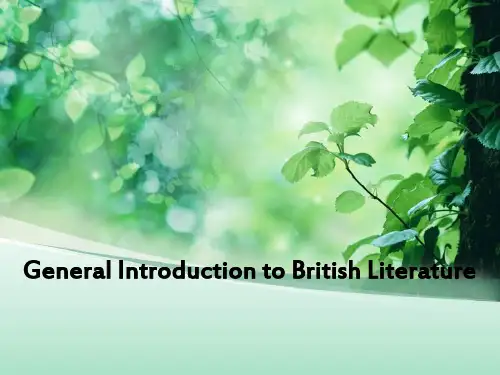
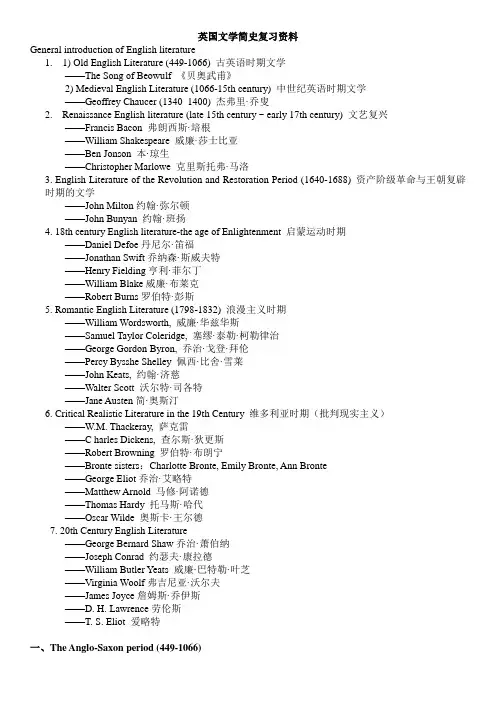
英国文学简史复习资料General introduction of English literature1. 1) Old English Literature (449-1066) 古英语时期文学——The Song of Beowulf 《贝奥武甫》2) Medieval English Literature (1066-15th century) 中世纪英语时期文学——Geoffrey Chaucer (1340_1400) 杰弗里·乔叟2. Renaissance English literature (late 15th century ~ early 17th century) 文艺复兴——Francis Bacon 弗朗西斯·培根——William Shakespeare 威廉·莎士比亚——Ben Jonson 本·琼生——Christopher Marlowe 克里斯托弗·马洛3. English Literature of the Revolution and Restoration Period (1640-1688) 资产阶级革命与王朝复辟时期的文学——John Milton约翰·弥尔顿——John Bunyan 约翰·班扬4. 18th century English literature-the age of Enlightenment 启蒙运动时期——Daniel Defoe丹尼尔·笛福——Jonathan Swift乔纳森·斯威夫特——Henry Fielding亨利·菲尔丁——William Blake威廉·布莱克——Robert Burns罗伯特·彭斯5. Romantic English Literature (1798-1832) 浪漫主义时期——William Wordsworth, 威廉·华兹华斯——Samuel Taylor Coleridge, 塞缪·泰勒·柯勒律治——George Gordon Byron, 乔治·戈登·拜伦——Percy Bysshe Shelley 佩西·比舍·雪莱——John Keats, 约翰·济慈——Walter Scott 沃尔特·司各特——Jane Austen简·奥斯汀6. Critical Realistic Literature in the 19th Century 维多利亚时期(批判现实主义)——W.M. Thackeray, 萨克雷——C harles Dickens, 查尔斯·狄更斯——Robert Browning 罗伯特·布朗宁——Bronte sisters:Charlotte Bronte, Emily Bronte, Ann Bronte——George Eliot乔治·艾略特——Matthew Arnold 马修·阿诺德——Thomas Hardy 托马斯·哈代——Oscar Wilde 奥斯卡·王尔德7. 20th Century English Literature——George Bernard Shaw乔治·萧伯纳——Joseph Conrad 约瑟夫·康拉德——William Butler Yeats 威廉·巴特勒·叶芝——Virginia Woolf弗吉尼亚·沃尔夫——James Joyce詹姆斯·乔伊斯——D. H. Lawrence劳伦斯——T. S. Eliot 爱略特一、The Anglo-Saxon period (449-1066)1、这个时期的文学作品分类:pagan(异教徒) ,Christian(基督徒)2、代表作:The Song of Beowulf《贝奥武甫》( national epic 民族史诗) 采用了隐喻metaphor手法3、Alliteration 头韵(写作手法)例子:of m an was the m ildest and m ost beloved,To his k in the k indest, k eenest for praise.二、The Anglo-Norman period (1066-1350) 盎格鲁—诺曼时期1、romance 传奇文学2、代表作:Sir Gawain and the Green Knight (高文爵士和绿衣骑士) 是一首押头韵的长诗三、Geoffrey Chaucer (1340-1400) 杰弗里·乔叟时期1、the father of English poetry 英国诗歌之父2、heroic couplet 英雄双韵体:a verse unit consisting of two rhymed(押韵) lines in iambic pentameter(五步抑扬格)3、代表作:The Canterbury Tales 《坎特伯雷的故事集》(英国文学史的开端)大致内容:the pilgrims are people from various parts of England, representatives of various walks of life and social groups. 朝圣者都是来自英国的各地的人,代表着社会的各个不同阶层和社会团体小说特点:each of the narrators tells his tale in a peculiar manner, thus revealing his own views and character. 这些叙述者以自己特色的方式讲述自己的故事,无形中表明了各自的观点,展示了各自的性格。
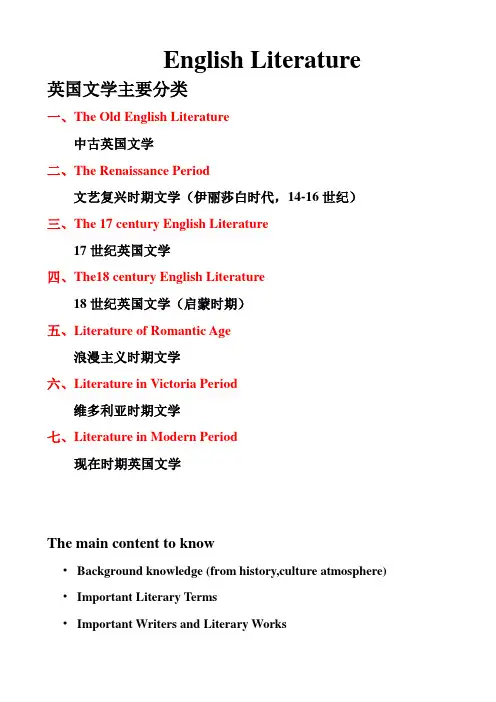
English Literature 英国文学主要分类一、The Old English Literature中古英国文学二、The Renaissance Period文艺复兴时期文学(伊丽莎白时代,14-16世纪)三、The 17 century English Literature17世纪英国文学四、The18 century English Literature18世纪英国文学(启蒙时期)五、Literature of Romantic Age浪漫主义时期文学六、Literature in Victoria Period维多利亚时期文学七、Literature in Modern Period现在时期英国文学The main content to know•Background knowledge (from history,culture atmosphere) •Important Literary Terms•Important Writers and Literary WorksThe Old English Literature(一)General Introduction(总体介绍)The Old English literature(which lasted from 499 to 1066)isexclusively a verse(诗篇)literature in oral form.There were two groups of English poetry in this period-the first was the pagan(异教的)poetry represented by Beowulf,the second was the religious poetry represented by the works of Caedmon and Cynewulf.In the 8th century,Anglo-Saxon prose appeared.The most famous prose writers of that period were Venerable bede and Alfred the Great.After the Norman Conques,three languages existed in England,which were French spoken by the Normans,English spoken by the lower class and Latin spoken by the scholars and clergymen. The prevailing from of literature in the feudal England was the Romance.The Romance prospered for 300 years(1200-1500)from which we see an epitome(缩影)of the Middle Ages.In the 15th century,English ballads became very popular and the only important writer was Thomas Malory.(二)Important Literary TermsOld English(古英语):language spoken by the Anglo-Saxons is called the Old English,which is the foundation of English language and literature.Romance(中世纪的传奇故事):The Romance was the prevailing form of literature in the Middle Ages.It was a long composition, sometimes in verse, sometimes in prose, describing the life and adventures of a noble hero.(三)Important Writers and Literary Works1.Beowulf(《贝奥武甫》)Beowulf is the oldest poem in the English language and the most important spe-cimen of Anglo-Saxon literture.The main stories are based on the folk legends of the primitive northern tribes.2.Religious Poets(宗教诗人)Caedmon(卡德蒙,610-680)Caedmon is the first known religious poet of England.He is known as the father of English song, Caedmon’s Hymn (《卡德蒙的赞美诗》)is a praise poem in honor of god.Cynewulf(基涅武甫,公元九世纪)Cynewulf lived in the 9th century. He produced four poems, of which The Christ(《基督》)is the most characteristic. Throughout the poem, a deep love for Christ and reverence for Virgin Mary(圣母利亚)are expressed.3.Prose Writers(散文作家)Venerable Bede(可敬的比德,672-735)Bede,also referred to as Saint Bede(圣比德)or the Venerable Bede,is well known as an author and scholar,and his most famous work, Historia Ecclesiastica Gentis Anglorum, or An Ecclesiastica History of the English People(《英吉利人教会史》),gained him the title “The Father of English History”(英国史学之父)Alfred the Great(阿尔弗雷德大帝,849-899)Alfred is the only English monarch to be accorded the epithet “the Great”(唯一一个被授予“大帝”名号额英格兰国王).He was the first King of the West Saxons to style himself “King of the Anglo-saxons”(将自己命名为“盎格鲁-撒克逊之王”的西撒克逊国王).The Anglo-Saxon Chronicle(《盎格鲁-撒克逊编年史》)is a collection of annals(年鉴)in Old English chronicling the history of the Anglo-Saxons. original manusript of the Chronicle was created late in the 9th century, probably in Wessex,duing the reign of Alfred the Great.4.The Romance(传奇)Sir Gawain and the Green Knight(《高文爵士与绿衣骑士》)It is a romance of 2,530 lines derived from Celtic legend(凯尔特骑士).Sir Cawain, nephew of King Arthur, accepted the challenge of the Green Knight in the Green Chapel(绿教堂). At last, he got a girdle (腰带)as a gift from the Knight and his story became widely known.5.Age of Chaucer(乔叟时代)The 14th century is called “Age of Chaucer”.Chaucer and Langland(朗格兰,1332-1400,英国诗人),were the most important writers of age.Ceoffrey Chaucer(杰弗里·乔叟,1343-1400)Chaucer is acclaimed not only as “the father of English poetry”(英国诗歌之父),but also as “the father of English fiction (英国小说之父).His masterpiece, The Canterbury Tales(《坎特伯雷故事集》),is one of the most famous works in all literatures.Chaucer wrote in vivid and exact language; his poetry is full vigor and swiftness.Book of the Duchess 《公爵夫人之书》The House of Fame《声誉之宫》The Parliament of Fowls 《百鸟会议》The Legend of Good Women 《贤妇传说》Troilus and Criseyde 《特洛伊罗斯与克丽西达》6. The 15th Century Ballads(民歌,歌谣)Thomas Malory(托马斯·马洛礼,1405-1471)Tomas Malory wrote an important work called Le Morte d’Arthur(《亚瑟王之死》).The central concern is with the adventures of Arthur and his famous Knights of the Round Table(圆桌骑士).The book is very important in English literature.Its Arthurian materials have a strong influence on literature of later centuries.The Renaissance Period伊丽莎白时代,14—16世纪一)General Introduction(总体介绍)The Renaissance(文艺复兴)was a European phenomenon, which originated in Italy. The English Renaissance encouraged the reformation of the Church.In Elizabethan(伊丽莎白)period, English literature developed with great speed. The most distinctive achievement of Elizabethan literature is drama. Next to drama is the lyrical poetry(抒情诗),remarkable for its variety and freshness and romantic feeling.In that period, writing peotry became a fashion and England became “a nest of singing birds”. In tha same period, Francis Bacon wrote more than fifty excellent essays, which make him one of the best essayists(散文家)in English literature.(二)Important Literary Terms1)Renaissance:In the Renaissance Period, scholars began to emphasize the capacities of human mind and the achievements of human culture. So humanism(人文主义)became the keynote of English Renaissance. English Renaissance is divied into three periods:①the 1st period from 1516 to 1578 is called the beginning of the Renaissance.②The 2nd period from1578 to 1625 is known as the flowering period.③The 3rd period from 1625 to 1660 is the epilogue(尾声)of the Renaissance.2) Spenserian Stanza(斯宾塞诗体)Spenser invented a new verse form. Each stanza has nine lines, each of the first eight lines is in iambic pentameter and the ninth line is an iambic hexameter line.(每个诗节由九行组成,前八行为五步抑扬格,第九行为六步抑扬格。
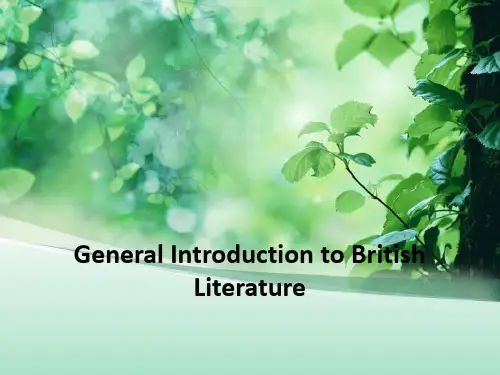
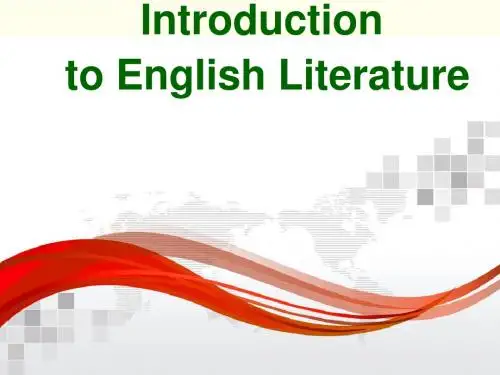
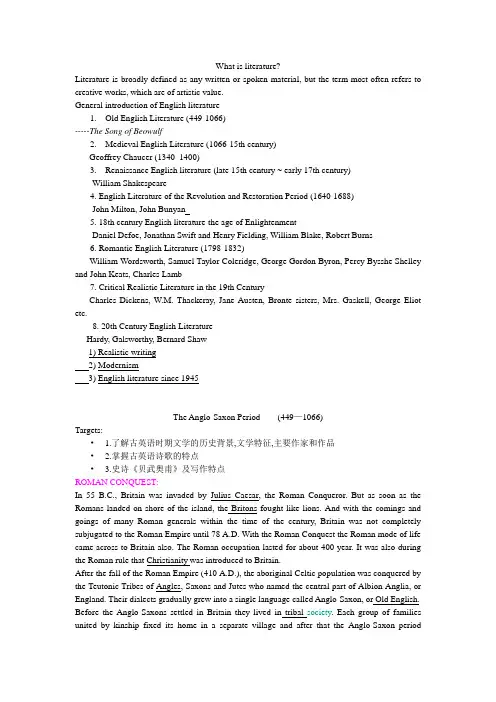
What is literature?Literature is broadly defined as any written or spoken material, but the term most often refers to creative works, which are of artistic value.General introduction of English literature1. Old English Literature (449-1066)-----The Song of Beowulf2. Medieval English Literature (1066-15th century)-----Geoffrey Chaucer (1340_1400)3. Renaissance English literature (late 15th century ~ early 17th century)------William Shakespeare4. English Literature of the Revolution and Restoration Period (1640-1688)------John Milton, John Bunyan5. 18th century English literature-the age of Enlightenment------Daniel Defoe, Jonathan Swift and Henry Fielding, William Blake, Robert Burns6. Romantic English Literature (1798-1832)-----William Wordsworth, Samuel Taylor Coleridge, George Gordon Byron, Percy Bysshe Shelley and John Keats, Charles Lamb7. Critical Realistic Literature in the 19th Century-----Charles Dickens, W.M. Thackeray, Jane Austen, Bronte sisters, Mrs. Gaskell, George Eliot etc.8. 20th Century English Literature----Hardy, Galsworthy, Bernard Shaw---- 1) Realistic writing---- 2) Modernism---- 3) English literature since 1945The Anglo-Saxon Period (449—1066)Targets:• 1.了解古英语时期文学的历史背景,文学特征,主要作家和作品• 2.掌握古英语诗歌的特点• 3.史诗《贝武奥甫》及写作特点ROMAN CONQUEST:In 55 B.C., Britain was invaded by Julius Caesar, the Roman Conqueror. But as soon as the Romans landed on shore of the island, the Britons fought like lions. And with the comings and goings of many Roman generals within the time of the century, Britain was not completely subjugated to the Roman Empire until 78 A.D. With the Roman Conquest the Roman mode of life came across to Britain also. The Roman occupation lasted for about 400 year. It was also during the Roman rule that Christianity was introduced to Britain.After the fall of the Roman Empire (410 A.D.), the aboriginal Celtic population was conquered by the Teutonic Tribes of Angles, Saxons and Jutes who named the central part of Albion Anglia, or England. Their dialects gradually grew into a single language called Anglo-Saxon, or Old English. Before the Anglo-Saxons settled in Britain they lived in tribal society. Each group of families united by kinship fixed its home in a separate village and after that the Anglo-Saxon periodwitnessed a transition from tribal society to feudal society.Literature characteristicsThe literature of this period is divided into pagan literature and Christian literature. The former represent poetry and in form of oral sagas. The later represents the writings developed under teaching of the monks. The poetry was copied by the monks and has the religious coloring and most of works can not find its scribe.Four main writers:•Caedmon, 凯德蒙the father of English song, is the first known religious poet of England. He wrote a poetic Paraphrase of the bible•Cynewulf produced the didactic poem The Christ•Venerable Bede, a monk who wrote in Latin and whose work The Ecclesiastical History of the English People earned for him the title of ―Father of English History‖.•Alfred the Great (848-901) wrote The Anglo-Saxon Chronicles. This book records the main happenings of the Anglo-Saxon period. It is the best monument of the Old English prose.古英语散文纪念碑The Song of Beowulf•Representative代表achievement of Anglo-Saxon periodThe Song of Beowulf is England‘s national epic. It was written by an unknown scribe at the beginning of the 10th century and was discovered in 1705. It reflects events which took place approximately at the beginning of the 6th century.Its chief significance lies in the vivid portrayal of a great national hero, who is brave, courageous, selfless, and ever helpful to his people and his kinsfolk.•The epic consists of 3182 lines and is to be divided into two parts.Writing Features of the Poem:•1) It is not a Christian but a pagan poem. The whole poem presents us an all-round picture of the tribal society and Christian culture,incorporating myth, legend, folk tale and history, which of national significance.•2) The use of the strong stress and the predominance of consonants are very notable in this poem. Each line is divided into two halves, and each half has two heavy stresses.•3) The use of the alliteration押头韵is another notable feature. Three stresses of the whole line are made even more emphatic by the use of alliteration.•4) A lot of metaphor and understatement are used in the poem. For example, the sea is called "the whale-road" or "the swan road"; the soldiers are called "shield-men"; the chieftains are called the "treasure keepers"; human-body is referred to as ―the bone- house‖; God is called ―wonder-wielder‖; Monster is referred to as ―soul-destroyer‖. Literary terms:•Epic: 叙事诗It is, originally, an oral narrative poem, majestic both in theme and style.Epics deal with legendary传奇or historical events of national or universal significance, involving action of broad sweep and grandeur. E.g.: Iliad 《伊利亚特》,Odyssey《奥德赛》Paradise Lost 《失乐园》,The Divine Comedy《神曲》。
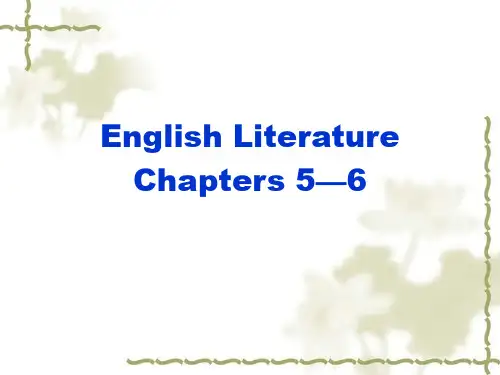
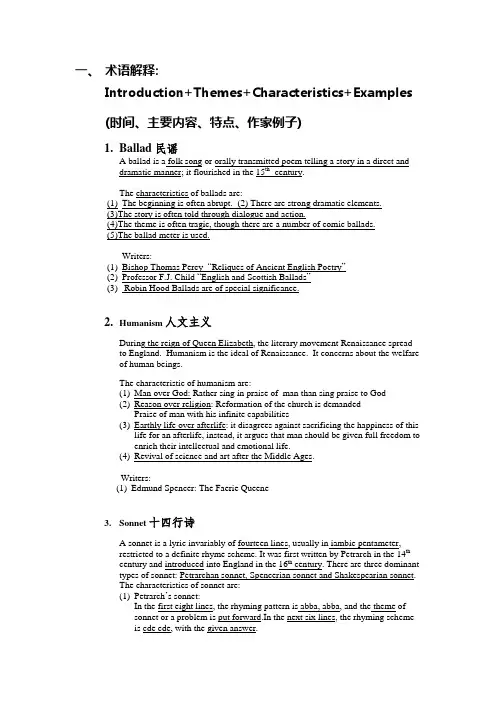
一、术语解释:Introduction+Themes+Characteristics+Examples(时间、主要内容、特点、作家例子)1.Ballad 民谣A ballad is a folk song or orally transmitted poem telling a story in a direct anddramatic manner; it flourished in the 15th century.The characteristics of ballads are:(1)The beginning is often abrupt. (2) There are strong dramatic elements.(3)The story is often told through dialogue and action.(4)The theme is often tragic, though there are a number of comic ballads.(5)The ballad meter is used.Writers:(1)Bishop Thomas Percy “Reliques of Ancient English Poetry”(2)Professor F.J. Child “English and Scottish Ballads”(3) Robin Hood Ballads are of special significance.2.Humanism 人文主义During the reign of Queen Elizabeth, the literary movement Renaissance spreadto England. Humanism is the ideal of Renaissance. It concerns about the welfareof human beings.The characteristic of humanism are:(1)Man over God: Rather sing in praise of man than sing praise to God(2)Reason over religion: Reformation of the church is demandedPraise of man with his infinite capabilities(3)Earthly life over afterlife: it disagrees against sacrificing the happiness of thislife for an afterlife, instead, it argues that man should be given full freedom toenrich their intellectual and emotional life.(4)Revival of science and art after the Middle Ages.Writers:(1)Edmund Spencer: The Faerie Queene3.Sonnet十四行诗A sonnet is a lyric invariably of fourteen lines, usually in iambic pentameter,restricted to a definite rhyme scheme. It was first written by Petrarch in the 14thcentury and introduced into England in the 16th century. There are three dominanttypes of sonnet: Petrarchan sonnet, Spencerian sonnet and Shakespearian sonnet.The characteristics of sonnet are:(1)Petrarch’s sonnet:In the first eight lines, the rhyming pattern is abba, abba, and the theme ofsonnet or a problem is put forward.In the next six lines, the rhyming schemeis cde cde, with the given answer.(2)Shakespeare’s sonnet:It starts with a rhyming scheme abab cdcd efef and end with a coupletrhyming gg. The theme is put forward and developed in the first threequatrains. A surprise conclusion or a shift of ideas is in the couplet.Poets:(1)Petrarch(2)Shakespeare’s 154 sonnets4.The Blank Verse(P164)The blank verse is used throughout the epic and is characterized by itsemployment of long and involved sentences, which run on many lines witha variety of pauses, and achieving sometimes an oratorical and sometimesan elaborately logical effect.Writer: ShakespeareJohn MiltonWilliam Wordsworth5. Satanic PoetsSatanic poets refer to a class of poets in the early 19th century, the age of romanticism, headed by George Gordon Byron, Percy Bysshe Shelley and John Keats. Their productions were characterized by Satanic spirit of pride and audacious of impiety. The characteristics of Satanic poets are that they were rebellious, revolutionary, romantic and they all lived a short life.6. ModernismM odernism is a term used to apply to the works of a group of poets, novelists, painters, and musicians between 1910 and the early years after the World War II. It includes imagism, expressionism, Dadaism, stream of consciousness, and existentialism. It means a departure from the conventional criteria or established values of the Victorian age.Alienation and loneliness are the basic themes of modernism.The characteristics of modernism are :(1) Complexity and obscurity(2) The use of symbols(3) Allusion (4)IronyWriters:Thomas Stearns Eliot “The Love Song of J.Alfred Prufrock”James Joyce “Ulysses”Stephen Spender “The Landscape Near An Aerodrome”7. Angry Young Generation(P259-260)Angry Young Generation refer to a group of young writers who were fiercely critical of the established order during the 50s.Most of them came from working class families and lower middle class. They wrote about the ugliness sordidness of life and exposed the hypocrisy of the genteel class. Their works were written in ordinary, sometimes dirty language. The scenes were usually set in the dark rooms or kitchens of industrial cities instead of the drawing rooms. The “heroes ” were bitter defeated men in society.Writers:John Osborne “Look Back in Anger”Kingsley Amis “Lucky Jim”John Wain “Hurry on Down”John Braine, “Room at the Top”Alan Sillitoe “Saturday Night and Monday Morning”8. The Theatre of the Absurd (P270)The Theatre of the Absurd is a term applied to a group of dramatists who were active in the 50’s. The name was probably coined by Martin Esslin in his book The Theatre of Absurd, published in 1961.The absurdity of human conditions is the main theme of the plays of the school of the theatre of the absurd. In the plays the dramatists express that life has no pattern of meaning or ultimate significance and that no activity is more or less valuable than another.Dramatists:Samuel Beckett “Waiting for Godot”Martin Esslin “The Theatre of the Absurd”。
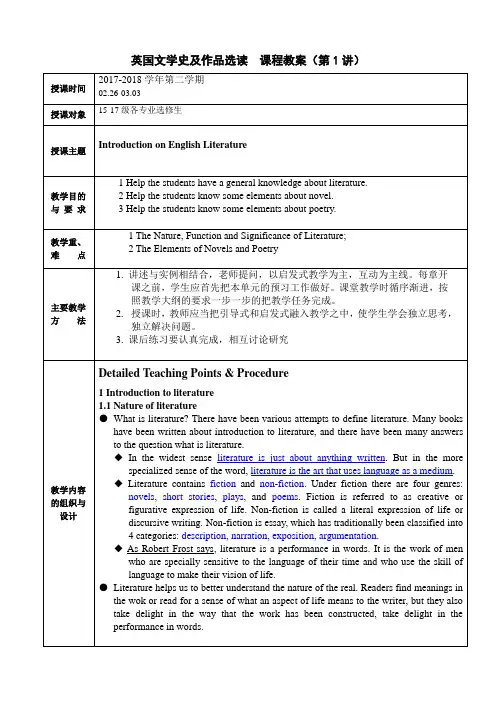
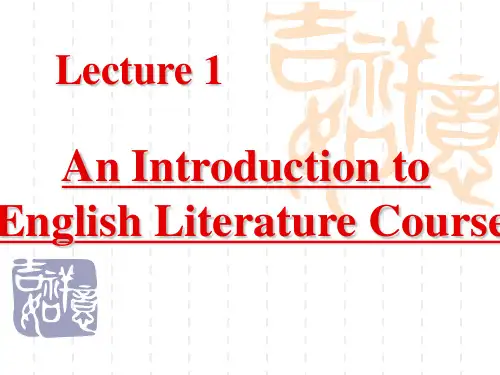
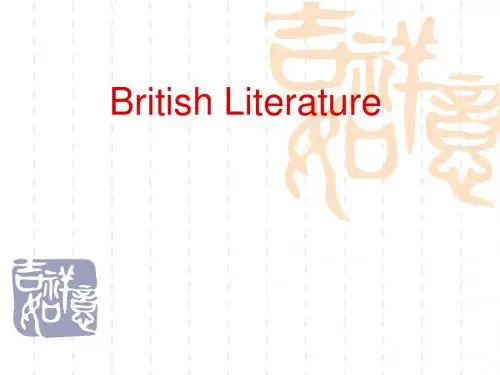
The brief introduction of British literatureBritish literature, composed of considerably beautiful poetry, interesting novels, meaningful dramas and fine prose, has a profound influence upon the world and demonstrates its distinguishing characteristics to the whole world. Moreover, it is generally considered as the essence of civilization as well as a bright pearl in the treasury of literature. The development of the English literature began from the 5th century to 20th century, with a long and complicated process. In the following passages, I will try to present the seven developing stages of English literature.Ⅰ. The Medieval Ages (to 1500)1.Major Historical Events1.1The Britons— the early inhabitants in the island were Britons, a tribe of Celts. 1.2Roman Conquest— a gradual process, happening in 55BC under Emperor Claudius.1.3English Conquest—In the 5th century, Angles(east), Saxon(southern) and Jutes(southeastern) were called Anglo-Saxon which invaded the GreatBritain.1.4The Danish Invasion— the Danes occupied in 1013, and held it for 30 years.1.5Norman Conquest—Duke William came in 1066—marks the establishment of feudalism.2.Literature Tide2.1 Narrative literature—Epic and romance (king Arthur and round table).2.2 Ballad—a story told in song usually in 4 line stanzas, with the second and forth line rhymed.2.3 Heroic couplet—Poems constructed from a sequence of rhyming pairs of iambic pentameter lines.3.Famous Writers and Masterpieces3.1 Beowulf—a hero of the Geats comes to the aid of Hrothgar, the king of the Danes, whose great hall, Heorot, is plagued by the monster Grendel…3.2 Sir Gawain and the Green knight—a late 14th-century Middle English alliterativeromance outlines an adventure of Sir Gawain, a knight of King Arthur's Round Table.3.3 Geoffrey Chaucer (1340-1400) is Father of English Literature.The Canterbury Tales—is a collection of short poetic stories.The Wife of Bath’s Tale—tells a story from a distant time, when King Arthur ruled the nation.Ⅱ. Renaissance1.Major Historical Events1.1England Civil War (1400-1500)—HenryⅦ (1458-1509) founded Tudor dynasty,a centralized monarchy.1.2Enclosure Movement—in the 15th century, England passed from a wool producer to a manufacturer of cloth.1.3Renaissance—sprang first in Italy in 14th century and gradually spread all over Europe.2.Literature Tide2.1 The Sonnet—a fourteen line lyrical poem, the Italian sonnet had a rigid rhyme scheme that divided the sonnet more or less into two separate halves.2.2 Epic Poetry—the most prized and respected literature of the Renaissance was epic poetry, usually written in Latin.2.3Drama—dealing with sacred subjects, such as biblical stories.3. Famous Writers and Masterpieces3.1 Francis Bacon—an English philosopher, statesman, scientist, lawyer, jurist, author and pioneer of the scientific method, has been called the creator of empiricism. Advancement of Learning—is considered the first step in the Great Instauration scale, of "partitions of the sciences".New Instrument—is divided in two parts, the first part b eing called “On the Interpretation of Nature and the Empire of Man”, and the second “On the Interpretation of Nature, or the Reign of Man”.3.2William ShakespeareFour Comedies—Midsummer Night of Dream, Venetian merchant, the 12th Night,Happy as You Like It.Four tragedies—Hamlet, Othello, Li King, Mike White.Ⅲ. The 17th Century1.Major Historical Events1.1English revolution and restoration1.2From 1642 to 1649, there was a Civil War, and Oliver Cromwell established a commonwealth.1.3In 1660, restoration made by CharlesⅡ.1.4In 1688, “glories revolution” made by William.2.Literature TideMetaphysical poetry—a group of 17th century English poets whose verse is characterized by an intellectually challenging style and extended metaphors comparing very dissimilar things. Their tool of doing this was the metaphysical conceit.3.Famous Writers and Masterpieces3.1 John Donne (1573--1631)—is the representative of the metaphysical poet.The Good-MorrowThe Sunne Rising3.2 John Milton (1608--1674)—English poet.Paradise LostParadise regainedⅣ. Age of Enlightenment1.Major Historical Events1.1French revolution (1789-1799)—was a period of radical social and political upheaval in French and European history.1.2Industrial revolution—starting in the later part of the 18th century there began a transition in parts of Great Britain’s previously manual labor and draft-animal-based economy towards machine-based manufacturing.2.Literature TideSentimentalism—dissatisfied with reason, sentimentalists appealed to sentiment, the human heart. It turned to countryside for material, marks the midway in the transition from classism to romanticism.3.Famous Writers and Masterpieces3.1Daniel Defoe (1660--1731) —English novelist, pamphleteer and journalist. Robinson Crusoe—help Defoe earn the title of the founder of English novel.The Review—is the first periodicals concerning society and policy.3.2Jonathan Swift (1667--1745) —the master of satire.Gulliver’s Travels—satirizing the corruption of the English governing class, and disclosing the dark side of the society.Ⅴ. Romantic period1.Major Historical Events1.1 French Revolution1.2 Industrial Revolution2.Literature TideIt was characterized by a highlighted interest in nature, emphasis on the individual’s expression of emotion and imagination, departure from the attitudes and forms of classicism, and rebellion against established social rules and conventions.3.Famous Writers and Masterpieces3.1 William Wordsworth (1770--1850) —together with Coleridge and Robert Southey are called “lake poet”.Lyrical Ballads— is the start of Romanticism.The Prelude—autobiography3.2Jane Austen (1775--1817)—an English prestigious writer.Sense and Sensibility—the first published novel.Pride and Prejudice—using the theme of marriage satirizes the life of English middle class in small towns.Ⅵ. Victorian Age1.Major Historical EventsDuring the rule of Queen Victoria, Britain occupied the leading status, therefore, its science, literature and art flourished.2.Literature TideAge of Novel—the 19th century saw the novel become the leading form of literature in English.3.Famous Writers and Masterpieces3.1 Charles Dickens (1812--1870) — is the greatest English novelist.Oliver Twist, Great Expectations, David Copperfield—has a close relationship with Dickens’ unfortunate childhood.Bleak House—discloses the decay and dark side of judicial system.3.2 Bronte Sister—Charlotte Bronte (1816—1855), Emily Bronte (1818--1848), Anne Bronte (1820--1849).Jane Eyre—Charlotte BronteWuthering Heights—Emily BronteAgnes Grey—Anne BronteⅦ.The Twentieth Century1.Major Historical Events1.1World WarⅠ (1914--1918) —British Empire collapsed.1.2Great Depression of the 1930s1.3World WarⅡ (1939--1945) —the United States and the Soviet Union emerged as very powerful nations.1.4Cold War (1947--1991)2.Literature Tide2.1 Modernism—a general term applied retrospectively to the wide range of experimental and avant-garde trends.2.2 Postmodernism—emphasizes devices, and mostly deconstruction.2.3 Stream of Consciousness—describes the writer’s point of view.3.Famous Writers and Masterpieces3.1 T. S. Eliot (1888--1965) —is arguably the most important English-language poetof 20th century.The Waste Land—using a lot of myth to describe the lost scene in spirit after war, rendering the hope of rebirth.3.2 D. H. Lawrence (1885--1930)—an English writer.Sons and LoversThe Rainbow,Women in Love。
英国文学简史General introduction of English literature1。
1) Old English Literature (449-1066)古英语时期文学——The Song of Beowulf 《贝奥武甫》2) Medieval English Literature (1066-15th century)中世纪英语时期文学—-Geoffrey Chaucer (1340_1400)杰弗里·乔叟代表作:French influence:Romance of the Rose《玫瑰传奇》The Book Of Duchess《公爵夫人之书》Italian influence:The Legend of Good Women《良妇传说》The House of Fame《声誉之堂》The Parliament of Fowls《百鸟议会》Troilus and Criseyde 《特罗勒斯与克莱西》Maturity:The Canterbury Tales《坎特伯雷故事集》2.Renaissance English literature (late 15th century ~early 17th century)文艺复兴-—-———-Thomas More 托马斯。
莫尔Utopia 乌托邦(1516)-——he gave a profound and truthful picture ofthe people’s sufferings and put forward hisideal of a future happy society.-—Francis Bacon 弗朗西斯·培根(1561——1626)The philosophical——-The Advancement of Learning《学术的推进》The literature —---—Essays《随笔》The professional works——-—--Thomas Wyatt托马斯怀亚特(1503-—1542)The first to introduce the sonnet into English literature(引入十四行诗的第一人)Lyrical poetry---—-—Edmund Spenser 埃德蒙斯宾塞(1552--1599)Poet's poet 诗人中的诗人The Faerie Queene 《仙后》(the greatest epic poem 史诗)The Shepheardes Calendar《牧人月历》——William Shakespeare 威廉·莎士比亚(1564-—1616)The most popular and the most wildly respected writer in all English literature四大悲剧:HamletOthelloKing LearMacbeth四大喜剧:A Midsummer Night’s DreamThe merchant of VeniceAs you like itTwelfth Night-—Christopher Marlowe 克里斯托弗·马洛The greatest of the pioneers of English dramaThe one who first made blank verse the principal instrument of English dramaEnglish Literature of the Revolution and Restoration Period (1640-1688)资产阶级革命与王朝复辟时期的文学--———-—John Donne约翰多恩(a metaphysical poet 玄学诗人)代表作:”the flea"(跳骚)—love poem“Song”(歌)“A Valediction: Forbidden Morning”(别离辞:节哀)“Death be not proud”(死神,你莫骄傲)死亡时永恒的,不要害怕死亡,人死后可以超生,到天堂“The Canonization"(封圣)-—John Milton约翰·弥尔顿(puritan)Paradise Lost《失乐园》Paradise Regained《复乐园》Samson Agonistes《力士参孙》On his blindnessOn His Deceased Wife《悼念我的亡妻》-—John Bunyan 约翰·班扬The Pilgrim’s Progress《天路历程》—-—is written in theold-fashioned, medieval form of allegory and dream.4。